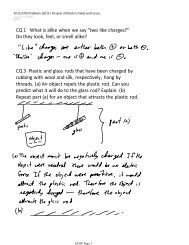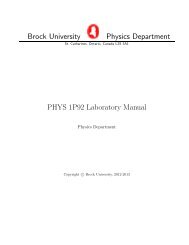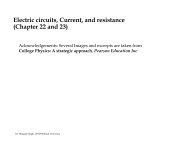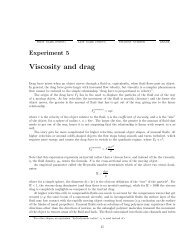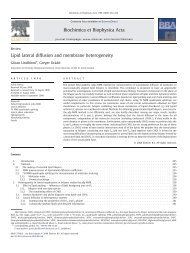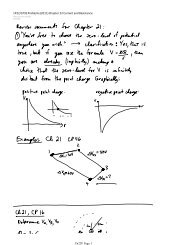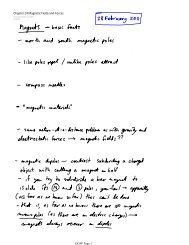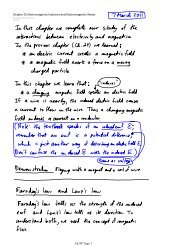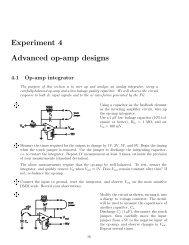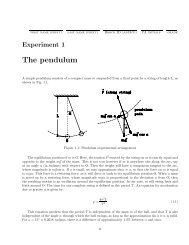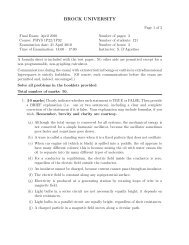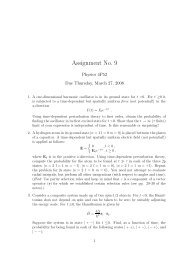Chapter 20 CP 57 In a simple model of the hydrogen atom, the ...
Chapter 20 CP 57 In a simple model of the hydrogen atom, the ...
Chapter 20 CP 57 In a simple model of the hydrogen atom, the ...
Create successful ePaper yourself
Turn your PDF publications into a flip-book with our unique Google optimized e-Paper software.
Exam Review Problems <strong>20</strong>11 Page 1<br />
1P22/1P92 Exam Review Problems <strong>20</strong>11<br />
Friday, January 14, <strong>20</strong>11<br />
10:03 AM<br />
<strong>Chapter</strong> <strong>20</strong><br />
True or false?<br />
1 It's impossible to place a charge on an insulator, because no<br />
current can flow in an insulator. F. Charges can be transferred from<br />
<strong>the</strong> surface <strong>of</strong> one insulator to <strong>the</strong> surface <strong>of</strong> ano<strong>the</strong>r insulator (by<br />
friction, for example) without a current flowing within <strong>the</strong> insulator.<br />
(And ano<strong>the</strong>r thing: it's not impossible for a current to flow within<br />
an insulator, just very difficult; that is, it takes an extremely high<br />
voltage, and would result in extreme damage to <strong>the</strong> insulator.)<br />
2 <strong>In</strong> an electric field, <strong>the</strong>re is only a force at <strong>the</strong> field lines;<br />
between <strong>the</strong> field lines <strong>the</strong>re is no force. F. <strong>In</strong> a contour map, only<br />
certain heights are indicated by <strong>the</strong> contour lines; <strong>the</strong> "in-between"<br />
heights are still <strong>the</strong>re, but <strong>the</strong>y are not indicated. Similarly, field<br />
lines are meant to give one a sense for <strong>the</strong> strength and direction <strong>of</strong><br />
<strong>the</strong> field at various points in space. The field exists everywhere in<br />
space, but <strong>the</strong> field lines represent <strong>the</strong> field only at certain points.<br />
3 The electric field inside a conductor at equilibrium is zero. T. If a<br />
field is applied to a "blob" <strong>of</strong> a conductor, <strong>the</strong>n free charges inside<br />
<strong>the</strong> conductor would flow to <strong>the</strong> surface <strong>of</strong> <strong>the</strong> conductor in such a<br />
way that <strong>the</strong> net field inside <strong>the</strong> conductor would be zero. The time<br />
needed for this process to occur is a very small fraction <strong>of</strong> a second.<br />
(If <strong>the</strong> conductor is in <strong>the</strong> form <strong>of</strong> a loop <strong>of</strong> wire, and <strong>the</strong> applied<br />
electric field is just so (for example, if it were created by connection<br />
<strong>of</strong> <strong>the</strong> loop <strong>of</strong> wire to a battery), <strong>the</strong>n it could be that equilibrium<br />
would "never" be reached; that is, a current could flow for a long<br />
time (until <strong>the</strong> battery is discharged).<br />
<strong>CP</strong> <strong>57</strong> <strong>In</strong> a <strong>simple</strong> <strong>model</strong> <strong>of</strong> <strong>the</strong> <strong>hydrogen</strong> <strong>atom</strong>, <strong>the</strong><br />
electron moves in a circular orbit <strong>of</strong> radius 0.053 nm around<br />
a stationary proton. How many revolutions per second does<br />
<strong>the</strong> electron make?
<strong>CP</strong> 67 A small charged bead has a mass <strong>of</strong> 1.0 g. It is held in a<br />
uniform electric field <strong>of</strong> magnitude E = <strong>20</strong>0,000 N/C, directed<br />
upward. When <strong>the</strong> bead is released, it accelerates upward with<br />
an acceleration <strong>of</strong> <strong>20</strong> m/s 2 . What is <strong>the</strong> charge on <strong>the</strong> bead?<br />
Exam Review Problems <strong>20</strong>11 Page 2
Exam Review Problems <strong>20</strong>11 Page 3<br />
<strong>Chapter</strong> 21<br />
True or false?<br />
1 Equipotentials are surfaces in space where <strong>the</strong> electrical<br />
potential is equally spaced. F. Equipotentials are surfaces in<br />
space on which <strong>the</strong> potential is constant.<br />
2 Equipotentials are always concentric spheres. F. Only in<br />
<strong>the</strong> <strong>simple</strong>st situations (a single point charge, a spherically<br />
symmetric charge distribution) are <strong>the</strong>y concentric spheres.<br />
3 When <strong>the</strong> plates <strong>of</strong> a parallel-plate capacitor are moved<br />
apart, <strong>the</strong> voltage between <strong>the</strong> plates decreases. F. If <strong>the</strong><br />
battery that charged <strong>the</strong> capacitor stays connected to <strong>the</strong><br />
plates while <strong>the</strong>y are moved apart, <strong>the</strong>n <strong>the</strong> voltage between<br />
<strong>the</strong> plates stays constant. On <strong>the</strong> o<strong>the</strong>r hand, if <strong>the</strong> battery<br />
charges <strong>the</strong> plates, <strong>the</strong>n is disconnected from <strong>the</strong> plates, and<br />
<strong>the</strong>n <strong>the</strong> plates are moved apart, <strong>the</strong> voltage between <strong>the</strong><br />
plates actually increases. You can understand this by looking at<br />
<strong>the</strong> formulas Q = CV and C = 0 A/d. As <strong>the</strong> distance between<br />
<strong>the</strong> plates increases, <strong>the</strong> capacitance decreases, by <strong>the</strong> second<br />
formula. Because <strong>the</strong> battery is disconnected, <strong>the</strong> charge on
Exam Review Problems <strong>20</strong>11 Page 4<br />
formula. Because <strong>the</strong> battery is disconnected, <strong>the</strong> charge on<br />
<strong>the</strong> plates remains constant; <strong>the</strong>refore, by <strong>the</strong> first formula, if<br />
<strong>the</strong> capacitance decreases, <strong>the</strong> voltage must increase.<br />
<strong>CP</strong> 65 The electric field strength is 50,000 V/m inside a<br />
parallel-plate capacitor with a 2.0 mm spacing. A proton is<br />
released from rest at <strong>the</strong> positive plate. What is <strong>the</strong> proton's<br />
speed when it reaches <strong>the</strong> negative plate?<br />
<strong>CP</strong> 70 Two 2.0-cm-diameter disks spaced 2.0 mm apart form<br />
a parallel-plate capacitor. The electric field between <strong>the</strong> disks<br />
is 5.0 × 10 5 V/m. (a) Determine <strong>the</strong> voltage across <strong>the</strong><br />
capacitor. (b) Determine <strong>the</strong> charge on each disk. (c.) An<br />
electron is launched from <strong>the</strong> negative plate. It strikes <strong>the</strong><br />
positive plate at a speed <strong>of</strong> 2.0 × 10 7 m/s. Determine <strong>the</strong><br />
electron's speed as it left <strong>the</strong> negative plate.
Exam Review Problems <strong>20</strong>11 Page 5<br />
<strong>Chapter</strong> 22<br />
True or false?<br />
1 When two identical light bulbs are connected in series to<br />
a battery, <strong>the</strong> one closer to <strong>the</strong> negative terminal <strong>of</strong> <strong>the</strong>
Exam Review Problems <strong>20</strong>11 Page 6<br />
a battery, <strong>the</strong> one closer to <strong>the</strong> negative terminal <strong>of</strong> <strong>the</strong><br />
battery is brighter, because <strong>the</strong> electrons reach this light<br />
bulb first. F. Electrons move simultaneously in all points <strong>of</strong><br />
<strong>the</strong> series circuit, so electrons flow in both light bulbs at <strong>the</strong><br />
same time. The light bulbs are equally bright.<br />
2 When two identical light bulbs are connected in series to<br />
a battery, <strong>the</strong> one closer to <strong>the</strong> negative terminal <strong>of</strong> <strong>the</strong><br />
battery is brighter, because some <strong>of</strong> <strong>the</strong> current is used up<br />
in <strong>the</strong> first light bulb, so <strong>the</strong>re is not as much to flow through<br />
<strong>the</strong> second one. F. Current is NOT used up in a series circuit;<br />
<strong>the</strong> technical term for this is <strong>the</strong> principle <strong>of</strong> conservation <strong>of</strong><br />
current (which logically derives from <strong>the</strong> principle <strong>of</strong><br />
conservation <strong>of</strong> charge). Potential energy is used up in each<br />
light bulb. The light bulbs are equally bright.<br />
3 Longer wires have less resistance than shorter wires,<br />
because <strong>the</strong> electrons have more room to spread out in a<br />
longer wire. F. The resistance <strong>of</strong> a wire is proportional to <strong>the</strong><br />
length <strong>of</strong> <strong>the</strong> wire, so longer wires have more resistance<br />
than shorter wires <strong>of</strong> <strong>the</strong> same material and same crosssectional<br />
area.<br />
A 60 W bulb and a 100 W bulb are connected in series to a<br />
battery. Which is brighter?
Exam Review Problems <strong>20</strong>11 Page 7<br />
<strong>CP</strong> 40 An electric eel develops a potential difference <strong>of</strong><br />
450 V, driving a current <strong>of</strong> 0.80 A for a 1.0 ms pulse. For<br />
this pulse, determine (a) <strong>the</strong> power, (b) <strong>the</strong> total energy,<br />
and (c.) <strong>the</strong> total charge that flows.<br />
<strong>CP</strong> 47 Air isn't a perfect insulator, but it has a very high<br />
resistivity. Dry air has a resistivity <strong>of</strong> about 3 × 10 13 Ω m. A<br />
capacitor has square plates 10 cm on a side separated by 1.2<br />
mm <strong>of</strong> dry air. If <strong>the</strong> capacitor is charged to 250 V, what<br />
fraction <strong>of</strong> <strong>the</strong> charge will flow across <strong>the</strong> air gap in 1 minute?
Exam Review Problems <strong>20</strong>11 Page 8<br />
Make <strong>the</strong> approximation that <strong>the</strong> potential difference doesn't<br />
change as <strong>the</strong> charge flows.<br />
<strong>Chapter</strong> 23<br />
True or false?
Exam Review Problems <strong>20</strong>11 Page 9<br />
True or false?<br />
1 Two identical light bulbs connected in series to a battery will<br />
be brighter than <strong>the</strong> same light bulbs connected in parallel to<br />
<strong>the</strong> same battery, because <strong>the</strong> full current flows through <strong>the</strong>m<br />
when <strong>the</strong>y are in series, whereas in parallel each light bulb gets<br />
only part <strong>of</strong> <strong>the</strong> current. F. The effective resistance <strong>of</strong> <strong>the</strong> two<br />
bulbs in series is more than <strong>the</strong> resistance <strong>of</strong> each bulb in<br />
parallel. Thus, more current flows through each bulb in parallel<br />
than <strong>the</strong> two bulbs in series, and <strong>the</strong>refore <strong>the</strong> power<br />
dissipated by each bulb in parallel is more than <strong>the</strong> power<br />
dissipated by both bulbs in series.<br />
2 Two identical light bulbs connected in parallel to a battery<br />
will consume more power than <strong>the</strong> same light bulbs connected<br />
in series to <strong>the</strong> same battery, because more current will flow<br />
when <strong>the</strong>y are in parallel. T, as explained in question 1.<br />
3 Connecting more resistors in series increases <strong>the</strong> effective<br />
resistance, whereas connecting more resistors in parallel<br />
decreases <strong>the</strong> effective resistance. T, as you can see by<br />
examining <strong>the</strong> formulas for effective resistance <strong>of</strong> resistors in<br />
series and parallel.<br />
<strong>CP</strong> 28 For <strong>the</strong> given circuit, determine <strong>the</strong> values <strong>of</strong> V 14 ,<br />
V 24 , and V 34 .
Exam Review Problems <strong>20</strong>11 Page 10
Exam Review Problems <strong>20</strong>11 Page 11<br />
<strong>Chapter</strong> 24<br />
True or false?<br />
1 Only current in a loop <strong>of</strong> wire creates a magnetic field;<br />
current in a straight line produces magnetic forces, but not a<br />
magnetic field. F. Every electric current produces a magnetic<br />
field; if ano<strong>the</strong>r charged particle should be moving so that its<br />
motion is not parallel to <strong>the</strong> magnetic field, <strong>the</strong>n <strong>the</strong> particle<br />
will feel a magnetic force due to <strong>the</strong> magnetic field.
Exam Review Problems <strong>20</strong>11 Page 12<br />
will feel a magnetic force due to <strong>the</strong> magnetic field.<br />
2 If a charged particle moves parallel to a uniform magnetic<br />
field, <strong>the</strong>re will be no magnetic force on <strong>the</strong> charged particle. T.<br />
Consider <strong>the</strong> formula F = qvB sin(θ); when <strong>the</strong> charged particle<br />
moves parallel to <strong>the</strong> field, <strong>the</strong> angle is 0, and so <strong>the</strong> formula<br />
predicts a force <strong>of</strong> 0.<br />
3 A magnetic field exerts a force on a particle at rest, but only<br />
if <strong>the</strong> particle is electrically charged. F. Using <strong>the</strong> same formula<br />
as in <strong>the</strong> previous question, if <strong>the</strong> speed is 0, <strong>the</strong>n <strong>the</strong> force will<br />
also be 0.<br />
<strong>CP</strong> 19 <strong>In</strong> <strong>the</strong> Bohr <strong>model</strong> <strong>of</strong> <strong>the</strong> <strong>hydrogen</strong> <strong>atom</strong>, <strong>the</strong> electron<br />
moves in a circular orbit <strong>of</strong> radius 5.3 × 10 -11 m with a speed<br />
<strong>of</strong> 2.2 × 10 6 m/s. Determine <strong>the</strong> magnetic field at <strong>the</strong> centre<br />
<strong>of</strong> a <strong>hydrogen</strong> <strong>atom</strong> due to <strong>the</strong> motion <strong>of</strong> <strong>the</strong> electron.
<strong>CP</strong> 25 The microwaves in a microwave oven are produced in a<br />
special tube called a magnetron. The electrons orbit in a<br />
magnetic field at a frequency <strong>of</strong> 2.4 GHz, and as <strong>the</strong>y do so<br />
<strong>the</strong>y emit 2.4 GHz electromagnetic waves. What is <strong>the</strong><br />
strength <strong>of</strong> <strong>the</strong> magnetic field?<br />
Exam Review Problems <strong>20</strong>11 Page 13
<strong>CP</strong> 59 A long straight wire with a linear mass density <strong>of</strong> 50<br />
g/m is suspended by threads, as shown in <strong>the</strong> figure. There is<br />
a uniform magnetic field pointing vertically downward. A 10 A<br />
current in <strong>the</strong> wire experiences a horizontal magnetic force<br />
that deflects it to an equilibrium angle <strong>of</strong> 10°. Determine <strong>the</strong><br />
strength <strong>of</strong> <strong>the</strong> magnetic field.<br />
Exam Review Problems <strong>20</strong>11 Page 14
Exam Review Problems <strong>20</strong>11 Page 15<br />
<strong>Chapter</strong> 25<br />
True or false?<br />
1 A changing magnetic field always induces a current in a<br />
nearby loop <strong>of</strong> wire. F. A current will be induced only if <strong>the</strong><br />
magnetic flux through <strong>the</strong> loop <strong>of</strong> wire is changing; <strong>the</strong> flux will<br />
not change if <strong>the</strong> magnetic field is changing but is perpendicular<br />
to <strong>the</strong> axis <strong>of</strong> <strong>the</strong> loop (<strong>the</strong> flux through <strong>the</strong> loop will remain 0<br />
even as <strong>the</strong> magnetic field changes; think <strong>of</strong> rain falling through<br />
a window that is oriented in various directions).<br />
2 Faraday's law states that a current in a loop <strong>of</strong> wire induces a<br />
changing magnetic flux through <strong>the</strong> loop. F. It's <strong>the</strong> o<strong>the</strong>r way<br />
around: Faraday's law states that a changing magnetic flux<br />
through a loop <strong>of</strong> wire induces an emf in <strong>the</strong> loop <strong>of</strong> wire (which<br />
<strong>the</strong>n creates an electric current in <strong>the</strong> wire as long as it is a<br />
closed conducting loop).<br />
3 Electromagnetic waves are called transverse because <strong>the</strong><br />
electric and magnetic fields are translated into one ano<strong>the</strong>r as<br />
<strong>the</strong> wave moves. F. Electric and magnetic fields are NOT<br />
translated into one o<strong>the</strong>r in an electromagnetic wave. An<br />
electromagnetic wave is called transverse because <strong>the</strong> motion<br />
<strong>of</strong> <strong>the</strong> wave is perpendicular to <strong>the</strong> (moving) plane in which <strong>the</strong><br />
electric and magnetic fields oscillate. (See <strong>the</strong> diagram on page<br />
830 <strong>of</strong> <strong>the</strong> textbook.)<br />
<strong>CP</strong> 28 A radio antenna broadcasts a 1.0 MHz radio wave with<br />
25 kW <strong>of</strong> power. Assume that radiation is emitted uniformly in<br />
all directions. (a) Determine <strong>the</strong> wave's intensity 30 km from<br />
<strong>the</strong> antenna. (b) Determine <strong>the</strong> electric field amplitude at this<br />
distance.
Exam Review Problems <strong>20</strong>11 Page 16<br />
distance.<br />
<strong>CP</strong> 30 The intensity <strong>of</strong> a polarized electromagnetic wave is<br />
10 W/m 2 . Determine <strong>the</strong> intensity after passing through a<br />
polarizing filter whose axis makes <strong>the</strong> following angles with<br />
<strong>the</strong> plane <strong>of</strong> polarization. (a) 0° (b) 30° (c.) 45° (d) 60° (e) 90°<br />
<strong>CP</strong> 60 A TMS (transcranial magnetic stimulation) device<br />
creates very rapidly changing magnetic fields. The field near a<br />
typical pulsed-field machine rises from 0 T to 2.5 T in <strong>20</strong>0 µs.<br />
Suppose a technician holds his hand near <strong>the</strong> device so that<br />
<strong>the</strong> axis <strong>of</strong> his 2.0-cm-diameter wedding ring is parallel to <strong>the</strong><br />
field. (a) Determine <strong>the</strong> emf induced in <strong>the</strong> ring. (b) The<br />
wedding ring is gold and has a cross-sectional area <strong>of</strong> 4.0<br />
mm 2 ; determine <strong>the</strong> induced current. (The resistivity <strong>of</strong> gold is
Exam Review Problems <strong>20</strong>11 Page 17<br />
mm 2 ; determine <strong>the</strong> induced current. (The resistivity <strong>of</strong> gold is<br />
2.21 × 10 -8 Ω m.) (Can you see why TMS technicians are<br />
advised to remove all jewelry?)<br />
<strong>Chapter</strong> 26<br />
True or false?<br />
1 A transformer changes voltage to current and vice versa. F.<br />
A transformer enables an AC current in one loop <strong>of</strong> wire to<br />
induce an AC current in a nearby loop <strong>of</strong> wire. By adjusting <strong>the</strong><br />
number <strong>of</strong> turns in <strong>the</strong> primary and secondary loops <strong>of</strong> wire,<br />
<strong>the</strong> voltage in <strong>the</strong> secondary can be made larger or smaller
Exam Review Problems <strong>20</strong>11 Page 18<br />
than <strong>the</strong> voltage in <strong>the</strong> primary. Similarly, <strong>the</strong> current in <strong>the</strong><br />
secondary can be made larger or smaller than <strong>the</strong> current in<br />
<strong>the</strong> primary.<br />
2 The main difference between a ground fault circuit<br />
interrupter and a circuit breaker is that <strong>the</strong> former detects<br />
ground faults and <strong>the</strong> latter detects short circuits. F. A ground<br />
fault is a type <strong>of</strong> short circuit. A circuit breaker breaks a circuit<br />
when <strong>the</strong> current increases to beyond 15 A (typically),<br />
whereas a ground fault circuit interrupter breaks a circuit<br />
when <strong>the</strong> current increases to beyond about 5 mA.<br />
3 AC is much better than DC, because motors and generators<br />
cannot work with DC. F. There are motors and generators that<br />
work with DC, just as o<strong>the</strong>r types <strong>of</strong> motors and generators<br />
work with AC. AC current is used for household applications<br />
because it is easy using transformers to increase <strong>the</strong> voltage to<br />
very high levels so that it can be transmitted across country<br />
with minimal power loss, and <strong>the</strong>n transformed back down to<br />
safe levels for use in homes.<br />
<strong>CP</strong> 14 A science hobbyist has purchased a surplus power-pole<br />
transformer that converts 7.2 kV from neighbourhood<br />
distribution lines into 1<strong>20</strong> V for homes. He connects <strong>the</strong><br />
transformer "backward," plugging <strong>the</strong> secondary coil into a<br />
1<strong>20</strong> V outlet. Determine <strong>the</strong> rms voltage induced at <strong>the</strong><br />
primary coil.
Exam Review Problems <strong>20</strong>11 Page 19<br />
<strong>CP</strong> 52 A step-down transformer converts 1<strong>20</strong> V to 24 V, which<br />
is connected to a load <strong>of</strong> resistance 8.0 Ω. Determine <strong>the</strong><br />
resistance "seen" by <strong>the</strong> power supply connected to <strong>the</strong><br />
primary coil <strong>of</strong> <strong>the</strong> transformer.<br />
<strong>Chapter</strong> 28<br />
True or false?<br />
1 A "quantum jump" is an extraordinarily large change in<br />
some variable (such as energy, for example), much larger than<br />
what had typically been seen before. F. Energy levels for<br />
bound systems (such as an electron bound inside an <strong>atom</strong>) are<br />
quantized; this means that only certain energies are possible.<br />
A quantum jump is a transition from one <strong>of</strong> <strong>the</strong> allowed<br />
energies to ano<strong>the</strong>r allowed energy.<br />
2 <strong>In</strong> <strong>the</strong> photoelectric effect, increasing <strong>the</strong> intensity <strong>of</strong> <strong>the</strong><br />
incident light increases <strong>the</strong> current flowing in <strong>the</strong> apparatus. T.<br />
<strong>In</strong>creasing <strong>the</strong> intensity <strong>of</strong> <strong>the</strong> incident light increases <strong>the</strong><br />
number <strong>of</strong> photons, but not <strong>the</strong>ir energy. Therefore, <strong>the</strong>
Exam Review Problems <strong>20</strong>11 Page <strong>20</strong><br />
number <strong>of</strong> photons, but not <strong>the</strong>ir energy. Therefore, <strong>the</strong><br />
number <strong>of</strong> electrons ejected per unit time (which is <strong>the</strong><br />
current) will be increased (as long as <strong>the</strong> frequency <strong>of</strong> each<br />
photon is greater than <strong>the</strong> threshold frequency), but <strong>the</strong><br />
maximum kinetic energy <strong>of</strong> <strong>the</strong> ejected electrons will not<br />
increase.<br />
3 Each metal has a threshold frequency with respect to <strong>the</strong><br />
photoelectric effect; that is, for incident light with frequency<br />
below <strong>the</strong> threshold frequency, no electrons are ejected from<br />
<strong>the</strong> metal. T. For frequencies below <strong>the</strong> threshold frequency,<br />
<strong>the</strong> incident photons do not have enough energy; electrons<br />
that absorb photons with energy that is too small will not have<br />
enough energy to overcome <strong>the</strong> attractive forces <strong>of</strong> <strong>the</strong> metal<br />
and escape from <strong>the</strong> metal.<br />
<strong>CP</strong> 13 Light with a wavelength <strong>of</strong> 350 nm shines on a metal<br />
surface, which emits electrons. The stopping potential is<br />
measured to be 1.25 V. (a) Determine <strong>the</strong> maximum speed <strong>of</strong><br />
emitted electrons. (b) Calculate <strong>the</strong> work function and<br />
identify <strong>the</strong> metal.
<strong>CP</strong> 49 <strong>In</strong> a photoelectric-effect experiment, <strong>the</strong> maximum<br />
kinetic energy <strong>of</strong> electrons is 2.8 eV. When <strong>the</strong> wavelength <strong>of</strong><br />
<strong>the</strong> incident light is increased by 50%, <strong>the</strong> maximum kinetic<br />
energy <strong>of</strong> <strong>the</strong> electrons decreases to 1.1 eV. Determine <strong>the</strong> (a)<br />
work function <strong>of</strong> <strong>the</strong> cathode, and (b) <strong>the</strong> initial wavelength.<br />
Exam Review Problems <strong>20</strong>11 Page 21
<strong>CP</strong> 50 <strong>In</strong> a photoelectric-effect experiment, <strong>the</strong> stopping<br />
potential at a wavelength <strong>of</strong> 400 nm is 25.7% <strong>of</strong> <strong>the</strong> stopping<br />
potential at a wavelength <strong>of</strong> 300 nm. Of what metal is <strong>the</strong><br />
cathode made?<br />
Exam Review Problems <strong>20</strong>11 Page 22
Exam Review Problems <strong>20</strong>11 Page 23<br />
<strong>Chapter</strong> 29<br />
True or false?<br />
1 Energy levels <strong>of</strong> electrons in a <strong>hydrogen</strong> <strong>atom</strong> are<br />
quantized; this means that <strong>the</strong>ir energies cannot be known<br />
for certain, because <strong>of</strong> Heisenberg's uncertainty principle. F.<br />
The energy levels are quantized, which means that only<br />
certain energies are allowed. These allowed energy values can<br />
be calculated very precisely using quantum mechanics, and<br />
experiments verify <strong>the</strong> predictions very precisely.<br />
2 The only way for an electron in an <strong>atom</strong> to make a<br />
transition from one energy state to a higher energy state is to<br />
absorb a photon <strong>of</strong> <strong>the</strong> right amount <strong>of</strong> energy. F. An electron<br />
can be bumped by ano<strong>the</strong>r electron and absorb just enough<br />
energy from <strong>the</strong> collision to induce <strong>the</strong> transition to <strong>the</strong><br />
higher energy state.<br />
3 <strong>In</strong> an oxygen <strong>atom</strong>, not all <strong>of</strong> <strong>the</strong> electrons can be<br />
simultaneously in a 1s 2 state; this is a consequence <strong>of</strong> Pauli's<br />
exclusion principle. T. According to Pauli's exclusion principle,<br />
no two fermions (and electrons are fermions) can have <strong>the</strong><br />
same set <strong>of</strong> quantum numbers. Only two different sets <strong>of</strong><br />
quantum numbers are possible for electrons in <strong>the</strong> 1s 2 state,<br />
so <strong>the</strong> maximum number <strong>of</strong> electrons that can be in this state<br />
is 2.<br />
<strong>CP</strong> 44 A 2.55 eV photon is emitted from a <strong>hydrogen</strong> <strong>atom</strong>.<br />
Determine <strong>the</strong> Balmer formula n and m values corresponding<br />
to this emission.
<strong>CP</strong> 56 The first three energy levels <strong>of</strong> <strong>the</strong> fictitious element X<br />
are shown in <strong>the</strong> figure. (a) Determine <strong>the</strong> wavelengths<br />
observed in <strong>the</strong> absorption spectrum <strong>of</strong> element X. (b) State<br />
whe<strong>the</strong>r each <strong>of</strong> your wavelengths in Part (a) corresponds to<br />
ultraviolet light, visible light, or infrared light. (c.) An electron<br />
with a speed <strong>of</strong> 1.4 × 10 6 m/s collides with an <strong>atom</strong> <strong>of</strong> element<br />
X. Shortly afterward, <strong>the</strong> <strong>atom</strong> emits a 1240 nm photon. What<br />
was <strong>the</strong> electron's speed after <strong>the</strong> collision? Assume that,<br />
because <strong>the</strong> <strong>atom</strong> is so much more massive than <strong>the</strong> electron,<br />
<strong>the</strong> recoil <strong>of</strong> <strong>the</strong> <strong>atom</strong> is negligible.<br />
Exam Review Problems <strong>20</strong>11 Page 24
58 A fictitious <strong>atom</strong> has only two absorption lines in its<br />
spectrum, at 250 nm and 600 nm. What is <strong>the</strong> wavelength <strong>of</strong> <strong>the</strong><br />
one line in <strong>the</strong> emission spectrum that does not appear in <strong>the</strong><br />
absorption spectrum?<br />
Exam Review Problems <strong>20</strong>11 Page 25
Exam Review Problems <strong>20</strong>11 Page 26



